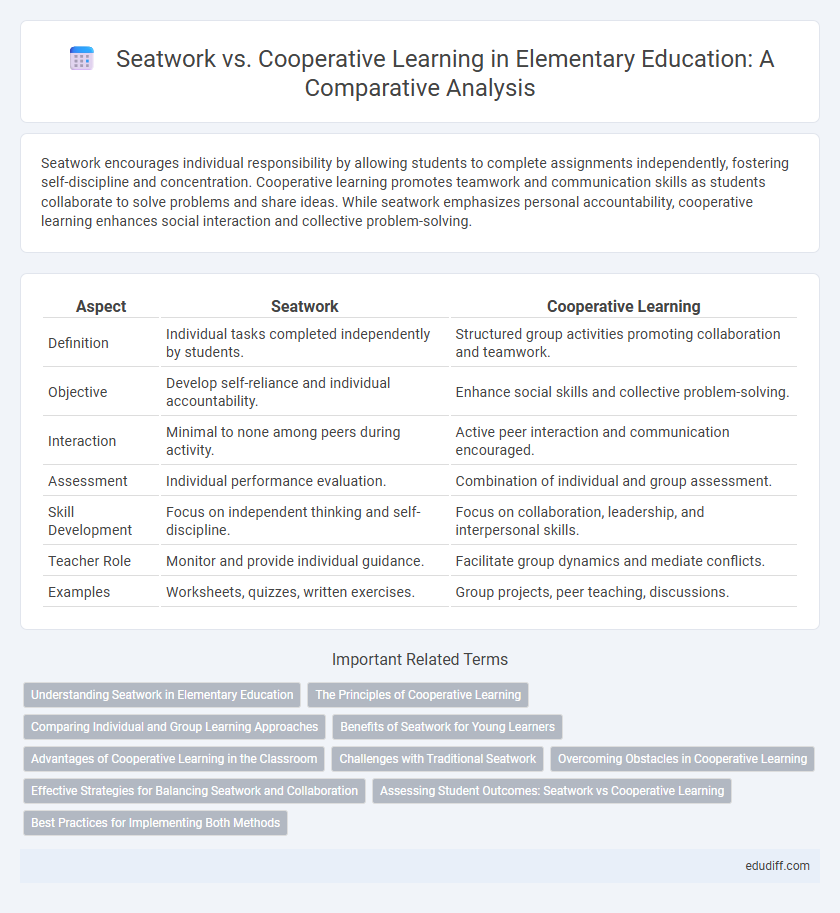Seatwork encourages individual responsibility by allowing students to complete assignments independently, fostering self-discipline and concentration. Cooperative learning promotes teamwork and communication skills as students collaborate to solve problems and share ideas. While seatwork emphasizes personal accountability, cooperative learning enhances social interaction and collective problem-solving.
Table of Comparison
| Aspect | Seatwork | Cooperative Learning |
|---|---|---|
| Definition | Individual tasks completed independently by students. | Structured group activities promoting collaboration and teamwork. |
| Objective | Develop self-reliance and individual accountability. | Enhance social skills and collective problem-solving. |
| Interaction | Minimal to none among peers during activity. | Active peer interaction and communication encouraged. |
| Assessment | Individual performance evaluation. | Combination of individual and group assessment. |
| Skill Development | Focus on independent thinking and self-discipline. | Focus on collaboration, leadership, and interpersonal skills. |
| Teacher Role | Monitor and provide individual guidance. | Facilitate group dynamics and mediate conflicts. |
| Examples | Worksheets, quizzes, written exercises. | Group projects, peer teaching, discussions. |
Understanding Seatwork in Elementary Education
Seatwork in elementary education involves individual tasks that students complete independently to reinforce skills and concepts taught in class. This method emphasizes personal responsibility, allowing students to practice problem-solving and critical thinking at their own pace. Effective seatwork activities are designed to align with curriculum standards and enhance mastery through focused repetition.
The Principles of Cooperative Learning
Cooperative learning is based on principles such as positive interdependence, individual accountability, and face-to-face promotive interaction, which encourage students to work together and support each other's learning. Unlike traditional seatwork, cooperative learning involves structured group activities that foster communication, collaboration, and critical thinking skills. This approach enhances student engagement and retention by promoting shared goals and mutual respect within diverse elementary classrooms.
Comparing Individual and Group Learning Approaches
Seatwork emphasizes individual task completion, encouraging student independence and self-paced learning in elementary classrooms. Cooperative learning involves students working in small groups, promoting collaboration, communication, and shared problem-solving skills. Research shows cooperative learning enhances social interaction and academic achievement, while seatwork supports personal responsibility and focus on individual strengths.
Benefits of Seatwork for Young Learners
Seatwork enables young learners to develop self-discipline and independent problem-solving skills by allowing focused, individualized practice. This method supports mastery of fundamental concepts through repetition and boosts confidence as students complete tasks at their own pace. Structured seatwork enhances concentration and fine motor skills, laying a strong foundation for academic success in elementary education.
Advantages of Cooperative Learning in the Classroom
Cooperative learning enhances student engagement by promoting collaboration and communication among peers, leading to improved social skills and deeper understanding of the material. Students working in groups benefit from diverse perspectives, which fosters critical thinking and problem-solving abilities. This approach also increases motivation and accountability, as learners rely on each other to achieve shared educational goals.
Challenges with Traditional Seatwork
Traditional seatwork in elementary classrooms often leads to student disengagement due to its repetitive and individual nature, which can hinder collaborative skills development. This approach limits opportunities for peer interaction and active learning, making it difficult to address diverse learning styles and needs. Challenges include decreased motivation, lack of critical thinking stimulation, and the potential for increased behavioral issues during solitary tasks.
Overcoming Obstacles in Cooperative Learning
Overcoming obstacles in cooperative learning involves addressing communication barriers, unequal participation, and conflicting opinions among elementary students. Effective strategies include establishing clear group roles, promoting active listening skills, and providing structured guidance from teachers to foster collaboration. These approaches enhance student engagement and improve learning outcomes compared to traditional seatwork methods.
Effective Strategies for Balancing Seatwork and Collaboration
Balancing seatwork and cooperative learning in elementary classrooms enhances student engagement and skill development. Effective strategies include scheduling focused individual tasks alongside collaborative group activities, using clear instructions and roles for cooperative learning to ensure accountability, and incorporating formative assessments to monitor progress and adjust the balance as needed. This approach maximizes both independent critical thinking and social interaction, fostering a well-rounded learning environment.
Assessing Student Outcomes: Seatwork vs Cooperative Learning
Assessing student outcomes in seatwork often emphasizes individual mastery and independent problem-solving through quizzes and worksheets. In contrast, cooperative learning assessments evaluate both group collaboration skills and individual contributions via peer reviews and group projects. Data from educational studies show cooperative learning can enhance critical thinking and communication skills compared to traditional seatwork.
Best Practices for Implementing Both Methods
Implementing seatwork effectively involves providing clear instructions, timely feedback, and tasks that match students' skill levels to promote independent learning and focus. Best practices for cooperative learning include forming diverse groups, assigning specific roles, and encouraging active communication to enhance collaboration and critical thinking. Combining both methods requires balancing individual accountability with group interdependence to maximize student engagement and achievement in elementary classrooms.
Seatwork vs Cooperative Learning Infographic

 edudiff.com
edudiff.com